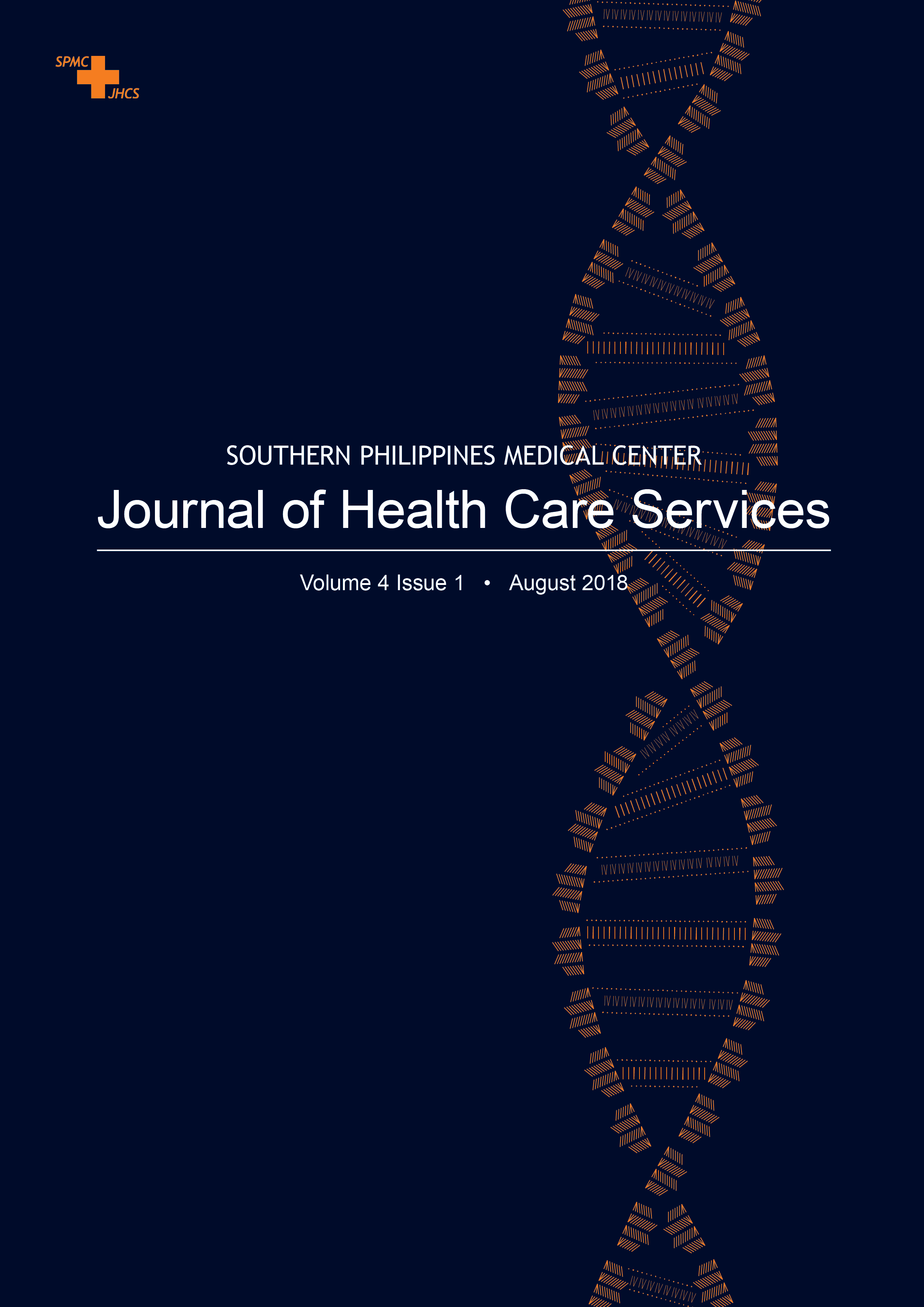Intersex: beyond binary sex markers
SPMC J Health Care Serv. 2018;4(1):10 ARK: http://n2t.net/ark:/76951/jhcs6mh5k6
1Commission on Human Rights XI, Trinity II Bldg 8 Quimpo Blvd, Ecoland, Davao City, Philippines
2Hospital Research and Publication Office, Southern Philippines Medical Center, JP Laurel Ave, Davao City, Philippines
Correspondence Michael John T Timajo, michaeljohnt04@gmail.com
Article editor Aileen Grace L Ang
Received 29 August 2018
Accepted 30 August 2018
Cite as Timajo MJT, Española SSB. Intersex: beyond binary sex markers. SPMC J Health Care Serv. 2018;4(1):10. http://n2t.net/ark:/76951/jhcs6mh5k6
Article source
Comissioned
Peer review
Internal
Competing interests
None declared
Access and license
This is an Open Access article licensed under the Creative Commons Attribution-NonCommercial 4.0 International License, which allows others to share and adapt the work, provided that derivative works bear appropriate citation to this original work and are not used for commercial purposes. To view a copy of this license, visit http://creativecommons.org/licenses/by-nc/4.0/
References
1. Republic v. Cagandahan, G.R. No. 166676. 2008 Sep 12.
2. GMA News Online [Internet]. SC ruling: 27-year-old ‘woman’ is ’male’. Manila: GMA News; 2008 September 16 [cited 2018 August 31]. Available from: http://www.gmanetwork.com/news/lifestyle/content/120751/sc-ruling-27-year-old-woman-is-male/story/. Accessed 2018 August 31.
3. Canada Institutes of Health Research [Internet]. Definitons of sex and gender. Ottawa: Canadaian Instituted of Health Research; 2015 June 17 [cited 2018 August 31]. Available from: http://www.cihr-irsc.gc.ca/e/47830.html. Accessed 2018 August 31.
4. World Health Organization [Internet]. Gender. Geneva: World Health Organization [cited 31 August 2018]. Available from: http://www.who.int/gender-equity-rights/understanding/gender-definition/en/. Accessed 2018 August 31.
5. Jones A. Redefining gender. National Geographic. 2017 January; 231(1).
6. Carpenter M. The human rights of intersex people: addressing harmful practices and rhetoric of change. Reproductive Health Matters. 2016; 24(47):74-84.
7. Health Policy Project, Asia Pacific Transgender Network, United Nations Development Programme. Blueprint for the Provision of Comprehensive Care for Trans People and Trans Communities. Washington: Futures Group, Health Policy Project; 2015.
8. Intersex Society of North America [Internet]. What do doctors do now when they encounter a patient with intersex? California: Intersex Society of North America; c1993-2008 [cited 2018 August 31]. Available from: http://www.isna.org/faq/standard_of_care. Accessed 2018 August 31.
9. Free and equal United Nations for LGBT equality. Fact sheet: Intersex. Geneva: United Nations Human Rights Office of the Higher Comissioner for Human Rights [cited 2018 August 31].
10. ILarsson N. Is the world finally waking up to intersex rights? 2016 February 10 [cited 2018 August 31]. In: The Guardian: International edition [Internet]. London: Guardian News and Media Limited. c2018. Available from: https://www.theguardian.com/global-development-professionals-network/2016/feb/10/intersex-human-rights-lgbti-chile-argentina-uganda-costa-rica. Accessed 2018 August 31.
11. Odero J. STATUS UNKNOWN: Intersex in Kenya: Held captive, beaten, hacked. Dead. 2015 Dec 23 [cited 2018 August]. In: Erasing 76 crimes [Internet]. California: 76 Crimes. c2017. Available from: https://76crimes.com/2015/12/23/intersex-in-kenya-held-captive-beaten-hacked-dead/. Accessed 2018 August 31.
12. Human Rights Watch [Internet]. Human rights watch country profiles: Sexual Orientation and Gender Identity. 2017 June 23 [cited 2018 August 31]. Available from: https://www.hrw.org/news/2017/06/23/human-rights-watch-country-profiles-sexual-orientation-and-gender-identity. Accessed 2018 August 31.
13. Transgender Europe [Internet]. Malta adopts ground-breaking trans and intersex law. 2015 April 1 [cited 31 August 2018]. Available from: https://tgeu.org/malta-adopts-ground-breaking-trans-intersex-law/. Accessed 2018 August 31.
14. Human Rights Watch [Internet]. “I want to be like nature made me”: Medically unnecessary surgeries on intersex children in the US. 2017 July 25 [cited 31 August 2018]. Available from: https://www.hrw.org/report/2017/07/25/i-want-be-nature-made-me/medically-unnecessary-surgeries-intersex-children-us. Accessed 2018 August 31.
15. Cayabyab MJ. House OKs LGBT anti-discrimination bill on final reading. 2017 September 20 [cited 2018 August 31]. In: The Philippine Daily Inquirer: News [Internet]. Makati: Inquirer Interactive, Inc. c1997-2018. Available from: http://newsinfo.inquirer.net/932095/house-oks-lgbt-anti-discrimination-bill-on-final-reading-discrimination-house-final-reading-hb-4982. Accessed 2018 August 31.
16.United Nations. Universal Declaration of Human Rights [Internet]. Available from: http://www.un.org/en/universal-declaration-human-rights/. Accessed 2018 August 31.
17. United Nations Human Rights Office of the High Commissioner [Internet]. Opening remarks by Zeid Ra’ad Al Hussein, United Nations High Commissioner for Human Rights at the Expert meeting on ending human rights violations against intersex persons. Geneva: United Nations Human Rights Office of the Higher Comissioner for Human Rights. c1996-2018 [cited 2018 August 31]. Available from: https://www.ohchr.org/EN/NewsEvents/Pages/DisplayNews.aspx?NewsID=16431. Accessed 2018 August 31.

This work is licensed under a Creative Commons Attribution-NonCommercial 4.0 International License.
Authors who publish with this journal agree to the following terms:
- Authors retain copyright and grant the journal right of first publication with the work simultaneously licensed under a Creative Commons Attribution-NonCommercial 4.0 International License that allows others to share the work for non-commercial purposes with an acknowledgement of the work's authorship and initial publication in this journal.
- Authors are able to enter into separate, additional, non-commercial contractual arrangements for the non-exclusive distribution of the journal's published version of the work (e.g., post it to an institutional repository or publish it in a book), with an acknowledgement of its initial publication in this journal.
- Authors grant the journal permission to rewrite, edit, modify, store and/or publish the submission in any medium or format a version or abstract forming part thereof, all associated supplemental materials, and subsequent errata, if necessary, in a publicly available publication or database.
- Authors warrant that the submission is original with the authors and does not infringe or transfer any copyright or violate any other right of any third parties.
